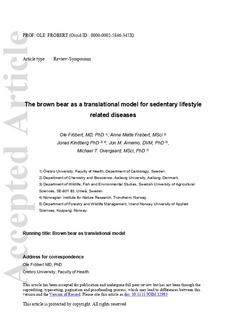The Brown bear as a translational model for sedentary lifestyle-related diseases
Peer reviewed, Journal article
Accepted version

Åpne
Permanent lenke
http://hdl.handle.net/11250/2642746Utgivelsesdato
2019Metadata
Vis full innførselSamlinger
- Scientific publications [1423]
Originalversjon
10.1111/joim.12983Sammendrag
Sedentary lifestyle accelerates biological ageing, is a major risk factor for developing metabolic syndrome
and is associated with cardiovascular disease, diabetes mellitus, kidney failure, sarcopenia and osteoporosis. In contrast to the linear path to worsening health in humans with metabolic syndrome,
brown bears have developed a circular metabolic plasticity enabling these animals to
tolerate obesity and a ‘sedentary lifestyle’ during hibernation and exit the den metabolically healthy
in spring. Bears are close to humans physiology wise, much closer than rodents, the preferred
experimental animals in medical research, and may better serve as translational model to develop
treatments for lifestyle-related diseases. In this review, aspects of brown bear hibernation survival
strategies are outlined and conceivable experimental strategies to learn from bears are described.